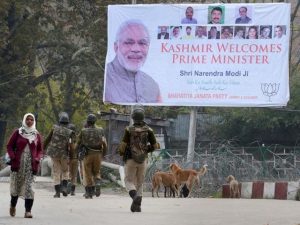
The Rising Tide of Obesity in Kashmir: Embracing Tradition for a Healthier Future
By: Saika J
Nestled amidst snow-capped peaks and emerald valleys, Kashmir has long been known for its breathtaking natural beauty and its unique cultural heritage. However, in recent years, a growing concern has emerged – the rising tide of obesity, particularly among the younger generation. This trend poses a significant threat to individual health and well-being, and necessitates immediate action.
A Growing Concern: The Kashmir Valley and the Obesity Curve
While traditionally associated with a leaner population, recent studies paint a concerning picture. A 2022 study published in the Indian Journal of Public Health revealed that the prevalence of overweight and obesity in Kashmir has risen to 25.4% among adults. This number is particularly alarming for the youth, with 18.5% of adolescents in the valley falling under the overweight or obese category as per a 2021 study published in the Journal of Family Medicine and Primary Care.
These statistics echo the national trend, with India facing a burgeoning obesity epidemic. According to a 2022 Lancet report, the number of overweight and obese children in India has increased dramatically, posing a significant public health challenge.
Untangling the Web: Factors Contributing to Kashmiri Obesity
The rise in obesity in Kashmir is a complex issue with multiple contributing factors. Here, we delve into some of the key culprits:
1. Shifting Dietary Patterns: The traditional Kashmiri cuisine, characterized by its focus on fresh vegetables, whole grains, and lean proteins like fish and chicken, has historically fostered a healthy lifestyle. However, recent decades have witnessed a concerning shift towards processed foods and fast food. The ubiquitous presence of refined carbohydrates and unhealthy fats in commercially available snacks and meals has significantly altered dietary habits, especially among the younger generation. This shift in dietary choices has contributed to increased calorie intake and decreased intake of essential nutrients.
2. The Enticement of Convenience: With the fast-paced nature of modern life, individuals are increasingly opting for convenient, ready-to-eat options. This often translates to reliance on fast food chains and processed snacks, which are typically high in calories, sugar, and unhealthy fats. Additionally, the decline in home-cooked meals further exacerbates the problem, as home-cooked meals offer greater control over ingredients and portion sizes.
3. The Lure of the Screen: The proliferation of digital technology has undoubtedly revolutionized communication and entertainment. However, it has also significantly impacted our physical activity levels. Increased screen time, whether spent watching television, playing video games, or browsing social media, often translates into less time spent engaging in physical activity. This sedentary lifestyle contributes to weight gain and increases the risk of developing various health complications.
4. Changing Social Norms: Traditionally, Kashmiri society has viewed chubby children as a sign of good health and prosperity. This perception, while gradually changing, still influences some families’ feeding practices, potentially leading to overfeeding and unhealthy weight gain in children.
5. Environmental Factors: While less understood, emerging research suggests a potential role of environmental factors in obesity. The changing gut microbiota due to increased use of pesticides and antibiotics may contribute to weight gain, although further research is needed to establish a definitive link.
Beyond the Scale: Embracing Tradition for a Healthier Future
Addressing the growing concern of obesity in Kashmir requires a multifaceted approach that involves individual responsibility, community support, and policy changes. Here are some key strategies to consider:
1. Rediscovering the Power of Tradition: Reconnecting with the rich culinary heritage of Kashmir offers a sustainable and healthy solution. By reviving traditional recipes that emphasize fresh, local ingredients, whole grains, and lean proteins, individuals can rediscover the power of nutritious and delicious home-cooked meals.
2. Embracing Movement: Encouraging regular physical activity is crucial in combating obesity. This need not involve strenuous gym routines. Fostering a culture of physical activity in everyday life, such as by walking, cycling, hiking, or engaging in traditional Kashmiri sports like Kokel (wrestling) and Kho-Kho (tag), can significantly improve overall health and well-being.
3. Empowering Choices: Promoting nutrition education and awareness campaigns can empower individuals to make informed choices about their food and lifestyle habits. This can involve collaborating with schools, community centers, and healthcare institutions to educate individuals about healthy eating habits, portion control, and the importance of physical activity.
4. Fostering a Supportive Environment: Creating a supportive environment that encourages healthy choices is essential. This involves promoting positive body image in society and challenging the traditional notions associated with weight and health
5. Leveraging Technology: Technology, while presenting challenges, can also be harnessed as a tool for positive change. Developing mobile applications that provide personalized coaching, healthy recipe suggestions, and fitness routines can empower individuals to take charge of their health and well-being. Additionally, utilizing social media platforms to spread awareness about healthy living and creating online communities that support healthy lifestyle choices can foster a sense of connection and motivation.
6. Policy and Advocacy: Addressing the obesity epidemic requires a collaborative effort that extends beyond individual choices. Advocating for policies that promote healthy eating habits, such as taxing sugary drinks and regulating the marketing of unhealthy foods to children, can create a supportive environment for healthy choices. Additionally, supporting initiatives that increase access to affordable, fresh fruits and vegetables can further facilitate healthier dietary patterns.
7. Strengthening Healthcare Systems: Equipping healthcare professionals with the knowledge and resources to effectively address obesity is crucial. This involves incorporating obesity management training into medical education curriculums and ensuring healthcare facilities have the necessary resources to diagnose, treat, and manage obesity effectively.
Conclusion: A Collective Journey Towards a Healthier Kashmir
Combating the rising tide of obesity in Kashmir necessitates a collective effort from individuals, communities, policymakers, and healthcare professionals. By rediscovering the power of tradition, embracing physical activity, making informed choices, and fostering a supportive environment, we can pave the way for a healthier and more vibrant future for the people of Kashmir. Remember, this journey towards a healthier Kashmir begins with each individual taking that first step, embracing the wisdom of the past, and choosing a life filled with vitality and well-being.

